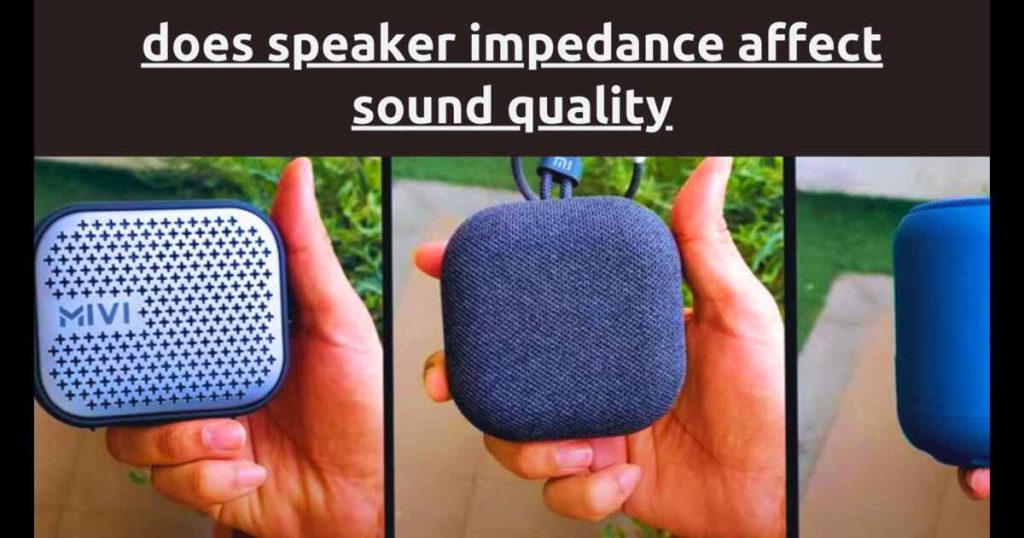
In the pursuit of superior sound, the impedance rating of Bluetooth speakers often serves as a guiding metric. However, the assumption that identical impedance ratings equate to identical sound quality warrants deeper scrutiny. This article investigates whether sound quality discrepancies exist among Bluetooth speakers sharing the same impedance, highlighting examples and elucidating factors contributing to these variations.
In this article we will find the answer to the question does speaker impedance affect sound quality? So, stay with us to learn everything about the impedance and its effect on the sound quality.
Read our comprehensive guide on impedance of Bluetooth speaker and also read How does Bluetooth speaker impedance impact wireless range?
Does Speaker Impedance Affect Sound Quality?
We will explore Sound Quality Variances in Bluetooth Speakers with Identical Impedance Ratings. The relationship between speaker impedance and sound quality is a multifaceted aspect in audio systems. While impedance itself doesn’t directly dictate sound quality, it indirectly influences it.
A speaker’s impedance interacts with the amplifier, affecting power transfer and, subsequently, volume and efficiency. However, sound quality is also influenced by various other factors like driver quality, enclosure design, and audio processing.
Understanding how impedance intertwines with these elements contributes to the overall audio experience but doesn’t solely determine sound quality.
Unveiling Impedance Similarities: Understanding Speaker Resistance
Grasping the similarity in impedance ratings among speakers is like discovering a shared language they all speak. It signifies the level of electrical resistance these speakers offer to the amplifier’s current.
Exploring this similarity aids in understanding the power requirements and compatibility with different amplifiers, ensuring an optimized performance tailored to the speakers’ specific impedance ratings. It’s akin to uncovering a common thread that unites these speakers in their ability to interact with amplifiers and produce high-quality sound.
Defining Common Impedance Ratings
Bluetooth speakers often boast similar impedance ratings, typically within the standard range of 4 to 8 ohms, leading users to expect uniform sound performance.
Expectations of Consistency
Assumptions prevail that identical impedance ratings promise uniform sound characteristics and quality across Bluetooth speaker models.
Unveiling Sound Quality Differences
Unveiling sound quality differences among speakers sheds light on the unique audio characteristics each one brings to the table. These differences stem from various factors such as speaker design, driver quality, enclosure materials, and tuning techniques.
Exploring these disparities provides insights into the nuances of sound reproduction, allowing us to appreciate how individual elements impact the overall audio experience.
Understanding these variations empowers us to make informed choices based on our preferences, ensuring that our audio setup aligns with our desired sound profile.
Speaker Design and Construction
Despite sharing identical impedance ratings, variations in speaker design, driver quality, enclosure materials, and signal processing impact sound reproduction.
Audio Processing and Tuning
Differences in onboard audio processing, tuning techniques, and equalization settings influence tonal balance and overall sound signature.
Examples of Sound Quality Variances
Example 1: Driver Configuration
Two Bluetooth speakers with the same impedance might differ in driver configuration, leading to variations in frequency response and bass output.
Example 2: Enclosure Design
Identical impedance speakers housed in distinct enclosures can exhibit differing resonance characteristics, affecting sound clarity and spatial imaging.
Understanding Factors Influencing Sound Variations
Technology and Innovation
Advancements in audio technologies, such as proprietary sound enhancement algorithms, impact sound quality despite shared impedance ratings.
Brand-Specific Sound Signatures
Manufacturer-specific tuning and branding ideologies shape sound signatures, resulting in perceptible differences among speakers with identical impedance.
Conclusion:
In the realm of Bluetooth speakers, identical impedance ratings don’t guarantee uniform sound quality. Variances in speaker design, driver configuration, enclosure characteristics, and brand-specific audio processing lead to perceptible differences in sound reproduction.
Understanding these nuances empowers users to appreciate the diverse sonic profiles, enabling informed choices aligned with personal audio preferences and usage scenarios.
I hope after reading this article now you are aware of impedance and its effect on sound quality.
